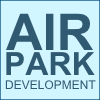 By Pepper Parr
By Pepper Parr
April 28th, 2015
BURLINGTON, ON
The public is slowly getting some input on what is done in the way of development at air parks. This will be good news to the people of Burlington. The city has taken the Burlington Air Park to court twice – and is in the process of seeking additional legal relief from a company that has done almost everything it can to not comply with the city’s bylaws
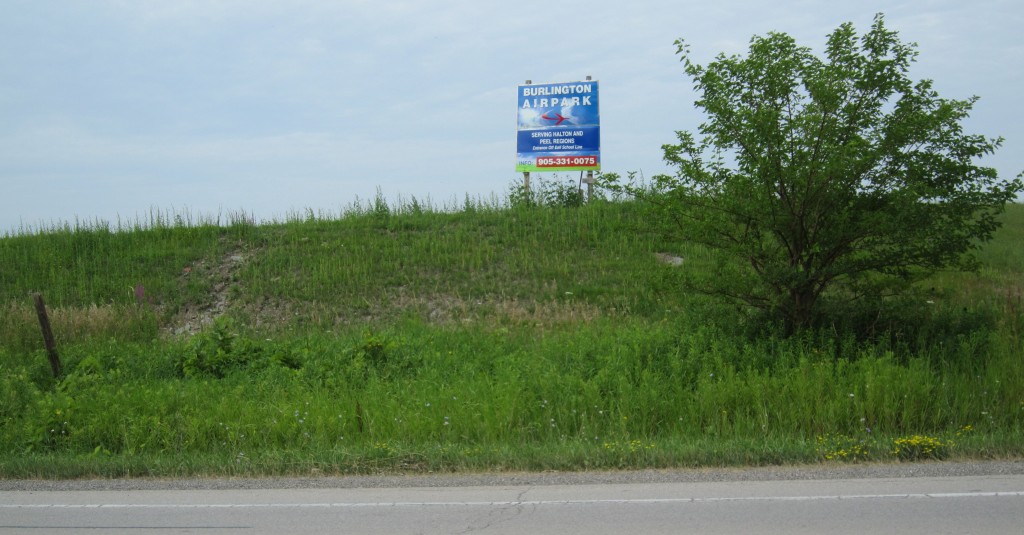
The only indication that there is an Air Park on Appleby Line is this one sign – everything else is hidden behind the large berm – put in place without site plan approval
Transport Canada has what is called the Canadian Aviation Regulation Advisory Council (CARAC) which recently asked for submissions on a proposed amendment to regulations and procedures related to Responsible Aerodrome Development.
A submission was made recently by Nancy Shea Nicol, City Solicitor & Director of Legal Services The Corporation of the City of Burlington and Mark Meneray, Commissioner of Legislative & Planning Services and Corporate Counsel for the Regional Municipality of Halton.
They were responding to the Notice of Proposed Amendment regarding Responsible Aerodrome Development and started by noting that comments will only be received until April 17th, 2015, which meant there has been insufficient time to prepare submissions for endorsement by our municipal councils.
It isn’t just the public that gets pushed to respond to changes that different levels of government make.
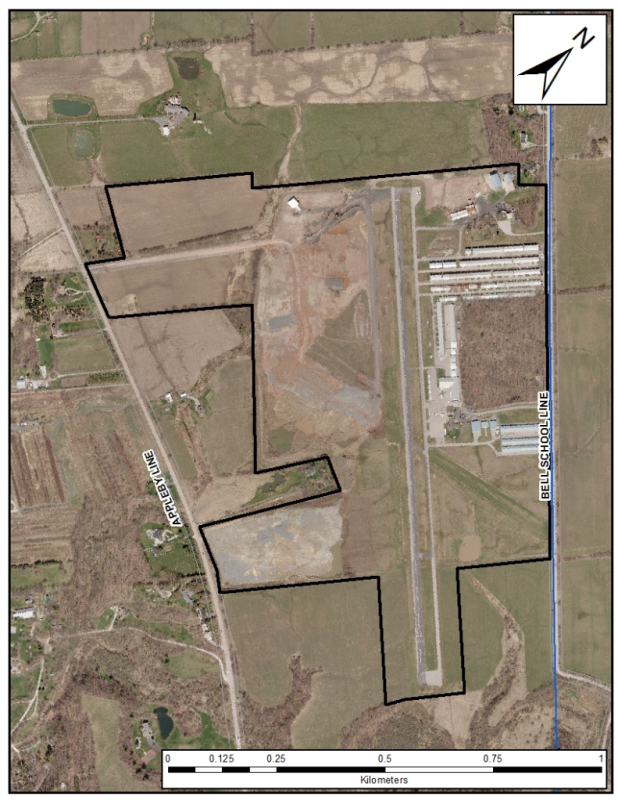
The air park property. The diagonal runway has been upgraded since this picture was taken
The Proposed Amendment provides that Transport Canada is seeking feedback from stakeholders on will require mandatory that public consultation processes be undertaken in respect of new aerodrome developments and existing certified and non-certified aerodromes when proposed development results in changes to the existing level of service or operations or usage.
Transport Canada is seeking input in setting the parameters of the following:
1. The circumstances under which the requirement to consult are applicable.
2. The mechanics of the consultation process including all steps to be taken.
3. The duration of the consultation process.
4. The defined dispute resolution process.
Before getting into the nitty gritty of their response the first thing Shea-Nicol and Meneray had to say was that the scope of the regulatory proposal itself is too narrow in terms of its applicability for the following reasons:

Vince Rossi, president of the Burlington Executive Air Park and believed to be the sole shareholder of the private company, met with north Burlington residents. He took all the comments made “under advisement”..
Recent amendments to the Aeronautics Act gave the Governor in Council the authority to make regulations with respect to mandatory consultations that must be carried out before the development of an aerodrome is developed or before an expansion of or change to the operations of an existing aerodrome. The amendments also gave the Governor in Council the authority to make regulations prohibiting the development or expansion of aerodromes or any change to the operation of them. It is our respectful submission that while the regulatory proposal speaks to stakeholder consultation, which we support in principle, it is silent on the circumstances under which the Governor in Council may exercise the power to prohibit the development or expansion of aerodromes or any change to the operation.
We are of the opinion, that in the absence of regulations governing when prohibition of development or expansion may occur, the duty to undertake a public consultation is somewhat “orphaned” in the larger regulatory context.
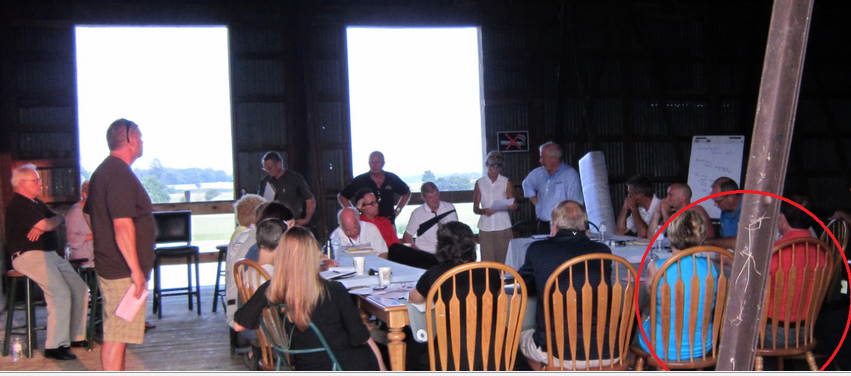
The only meeting with north Burlington residents that Vince Rossi attended took pl;ace in a barn at the end of one of the Air Park runways. Circled are Rossi and ward 6 Councillor Blair Lancaster
Under the recent amendments to the Aeronautics Act the Minister has the authority to make orders prohibiting the development or expansion of an aerodrome or any changes to its operation where the Minister is of the opinion that the proposed development, expansion or change is likely to adversely affect aviation safety or is not in the public interest. We would expect that the results of the mandatory consultation process should inform the Minister as to when a proposed development or change to an existing aerodrome might not be in the public interest. Again, the regulatory proposal is silent on how this power is to be exercised, and under what conditions.
Further to the above noted points, it is unclear as to what exactly the regulatory framework is, and in particular how it will apply to registered and non-registered aerodromes. It is fine to provide provisions for consultation with the public, but if that consultation is not linked to any power to prohibit or invoke Ministerial orders regulating aerodrome development or operations, it may be that the public consultation is more “window dressing” than substance.
All this before they get into their response to the Notice of proposed amendments.
The intention of all this is to create a process that allows for public input and consultation. The city and the Region want to make sure that the dice are not loaded in favour of an air park operator. You can be the ranch that the Air Park will be submitting their views which will be considerably different than those of the city.
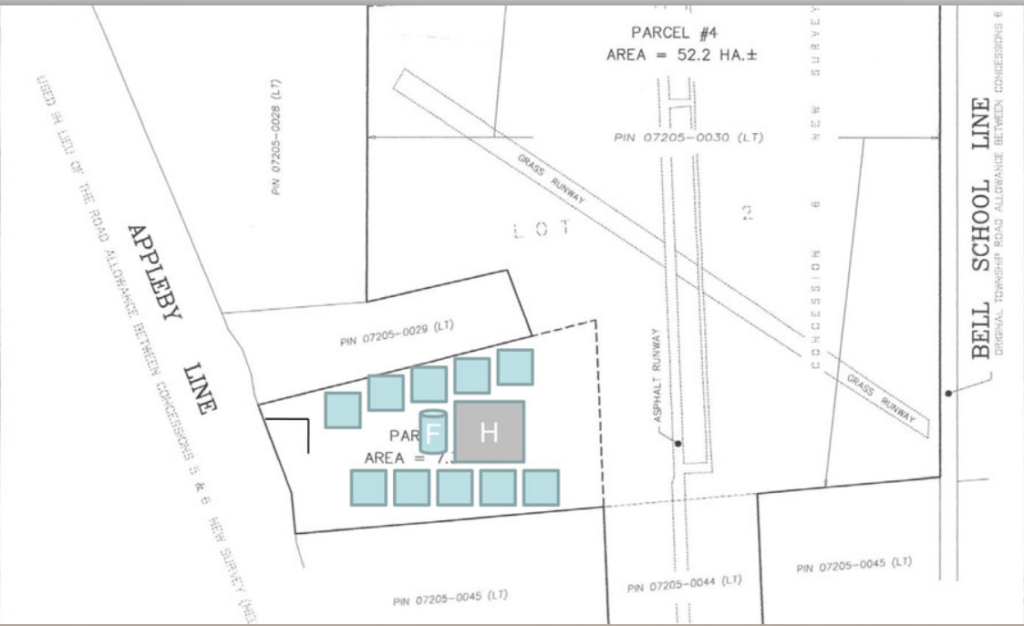
There were plans to build a heli-port dangerously close to a public road
What follows is as dry as toast – and critical to the development of rural Burlington. There was a point at which the air park wanted to build a helicopter pad that was dangerously close to a public road and almost in the front yard of a neighboring property owner. The Burlington Air Park had taken the position that they were a federally regulated operation and did not have to comply with municipal bylaws.
Justice Murphy put an end to that argument and said the Air Park was indeed required to abide by municipal bylaws and an appeal court agreed.
Nevertheless the Air Park has still not submitted the site alteration plan required – the city has once again gone to court and asking a judge to compel them to comply.
That is what makes this change in public participation process so very necessary.
1. CIRCUMSTANCES UNDER WHICH THE REQUIREMENT TO CONSULT
We support in principle the requirement for public consultation as is proposed as it addresses what has in the past, been a serious gap in public information and/or consultation with the local community when there is development or expansion or changes to existing aerodrome operations. This has been and continues to be a source of conflict between aerodrome operators and the communities in which they reside.
While applicability to new aerodrome development is relatively straightforward in the regulatory proposal, it is far less clear when dealing with existing aerodrome development. From the perspective of the public at large, it is very unclear as to when proposed modifications result in changes to existing levels of service or operation, or result or could reasonably result in changes to existing usage. For example, the change of the size of an aerodrome should be subject to public consultation, even if it does not change its immediate usage. The vagueness of these proposals raise questions such as:
1. Who and how is the threshold determined?
2. Is it NAV CANADA and/or Transport Canada who makes the threshold determination or the proponent?
3. Is there an opportunity to influence this determination through a preliminary consultation with stakeholders and the public on this point?
The regulatory proposal indicates that the local public, land-use authorities and nearby registered and certified aerodromes must be notified of a proposed aerodrome development where public consultation “is deemed to be a requirement”. Again, it is unclear who makes this determination – either the proponent, Transport Canada, or NAV CANADA?
2. MECHANICS OF THE CONSULTATION PROCESS
We could not determine what the prescribed notification radius is and therefore are unclear as to how broadly a proponent is required to consult. We suggest the notification radius may be too restrictive in respect of non-built up areas. Furthermore, the terms “built up” and “protected area” are undefined and integral to determining the notification area. Calculating the applicable radius, assuming there is one, is even less clear in applying it to existing aerodrome development.
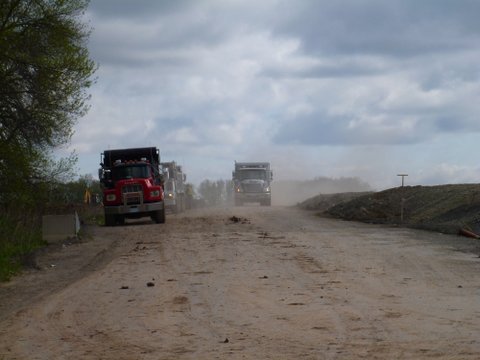
It was the dumpling of land fill without the proper papers that brought the illegal activity to the attention of city hall.
The environmental impacts of any development or proposed expansion of service is of particular concern to local communities.
It is curious that the public notification requires an attestation that the installation will adhere to local building and fire codes. Does Transport Canada concede that aerodromes are required to comply with local building code and fire code requirements? This language is repeated in the Community Comment Section and the concerns expressed here apply equally.
The same comment as above applies to the requirement that the proponent attest that local land-use authorities, “as applicable”, are engaged in the consultation process. This is ambiguous at best and should be clarified in order to ensure that local land use authorities are engaged in any consultation process.
The requirement that the proponent will respond to “all reasonable and relevant concerns” is ambiguous. Are we to assume that it is up to the proponent to determine which public concerns are “reasonable and relevant”? It is unrealistic to expect that the public or other government agencies will be able to assess “valid and substantiated safety” issues, “environmental considerations including the impact on environmentally sensitive or protected lands or aircraft noise within a 30 day response period as addressed below.
Equally of concern, environmental concerns that “are not scientifically sound” will not be considered reasonable or relevant. The process places the onus on the public to raise these concerns and establish their validity, rather than placing the onus on the proponent to have done this work in advance, assessed all of the impacts, and then present the proposal and scientific work to substantiate that the proposed development will not have a negative impact on the surrounding community.
The example list provided indicates that questions respecting whether locally established bylaws or other legislation, procedures or processes are applicable or should be amended in some manner will not be considered as a reasonable or relevant example of concern. This exclusion is too broad and could be used as a catch-all to deny reasonable and relevant concerns that may relate to or refer to bylaws, legislation or procedures. In addition, this seems contrary to the public consultation intent of the regulation and also seems to come to the incorrect conclusion that a bylaw, legislation or procedure or process cannot be applicable.to an aerodrome development.
Public comments including those that are determined to be unreasonable or irrelevant should be made publically available in order to ensure the transparency of the process.
Attempts to resolve concerns informally is positive, however the timelines for having these discussions is too short as discussed below. As well, it would appear that informal resolution will take place with individuals on a concern by concern basis, and not in a public or coordinated fashion. This could result in a “divide and conquer” strategy being used by the proponent to _address concerns raised by the public.
3. . DURATION OF THE CONSULTATION PROCESS
The timelines for public consultation are far too condensed. The regulatory proposal indicates that the proponent must ensure the public notification provides for at least 30 days for written public comment. Proponents will apply the 30 days as the maximum time required for comment. As regulators, Transport Canada has to appreciate that neither the public nor local municipal authorities have the resources (expert staff, funding) to be able to provide written comments on detailed aeronautic proposals within a 30 day window.
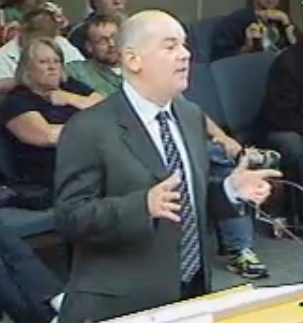
Glenn Grenier, lawyer for the Air Park, a pilot and a resident of the city got a little more than the time of day from a city council that decided they didn’t have all that much time for him.
For the consultation to be meaningful, sufficient time must be provided in order for the community to get the resources in place in order to properly understand the scale of the proposed development, and its impacts on the community. These resources are professional/expert in nature and will be costly to the community. Furthermore, most municipal councils only meet once per month and lead times required to get a report onto an agenda can be upwards of 30 days. Accordingly, in order to respond, municipal councils will require at least a 120 day notification period which to provide written comments in respect of a development proposal.
The window for holding the Community Information and Comment Session requires should be longer than the prescribed 14 – 20 days from the mailing of the notice or the publication in the local community newspaper. We would recommend that this window be set at a minimum of 60 days. This could take place within the 120 day period discussed above.
The 111 days for the concluding the public consultation process is too short. After the 120 day window for public comment and 30 days for proponent’s responses, there is only a 21 day opportunity for reply. This should be extended to 30 days. These timelines suggests that the consultation process should be at least 180 days.
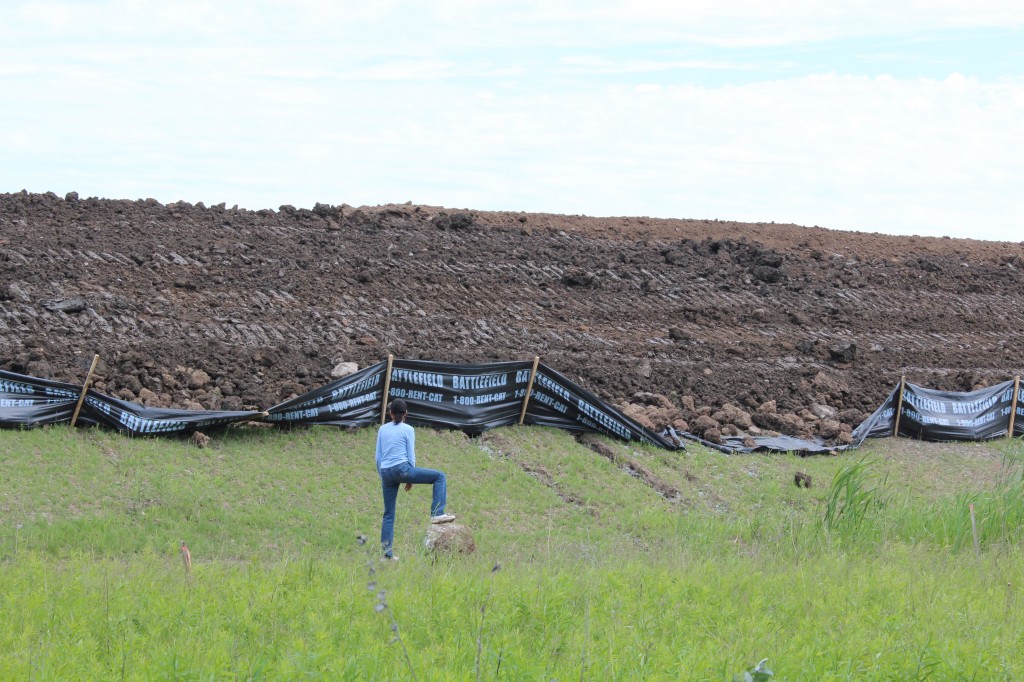
Air park dumped more than 30 feet of landfill without a Site Plan. Owner of the adjacent property stands on her property line and wonders why anyone can build a “small mountain” next to her property without getting approval. She is also terrified about what the hill is doing to the value of her property and what the leaching out of the landfill is going to do to her well water.
The Notice recognizes that proponents in more populated or sensitive areas should expect greater engagement in the consultation process that may extend the process beyond 111 days. An extended time frame should be recognized for more populated and sensitive areas in order to ensure the proponent engages the public appropriately in these circumstances.
4. THE DISPUTE RESOLUTION PROCESS.
The formal intention by Transport Canada into a dispute between the public and the proponent is a positive process. We are concerned however that the general public will not have the resources to deal on an equal and balanced playing field with the representatives of the proponent and Transport Canada.
The Transport Canada process for dispute resolution is simply mentioned as a ‘process’ in the Notice. The details of how dispute resolution will be managed by Transport Canada could be outlined in greater detail so participating parties have a reasonable expectation of what will be required should they enter into dispute resolution.

Second from the right is current Minister of Transport – second from the left is Vince Rossi at what is believed to have been an Air Park social event. The Minister has not met with the residents who are impacted by the air park.
The resolution window of 30 – 60 days is positive, however Transport Canada should ensure these timelines can be met.
The views of the city and the region are just one part of the comment process. Let’s see how close the regulations come to giving he citizens of the city of Burlington the opportunity to have real input on what gets built in their city.
This has been a five year grind and it isn’t over yet – but the trend line has changed and the arrogance with which legal counsel approached the city is now a thing of the past.



















Good to finally see the City’s legal team putting out something of real substance (and gosh, in public!!!) in responding to this Transport Canada proposal. Makes all the right points in revealing the flaws in the proposal when it comes to dealing with the public and resolving concerns. Yes it’s dry, but dry is all that lawyers understand and demand.